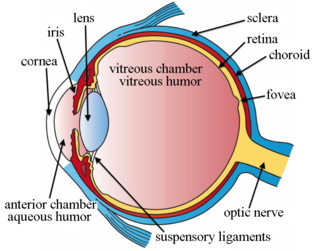Related Research Articles

Macular degeneration, also known as age-related macular degeneration, is a medical condition which may result in blurred or no vision in the center of the visual field. Early on there are often no symptoms. Over time, however, some people experience a gradual worsening of vision that may affect one or both eyes. While it does not result in complete blindness, loss of central vision can make it hard to recognize faces, drive, read, or perform other activities of daily life. Visual hallucinations may also occur but these do not represent a mental illness.

The Amsler grid, used since 1945, is a grid of horizontal and vertical lines used to monitor a person's central visual field. The grid was developed by Marc Amsler, a Swiss ophthalmologist. It is a diagnostic tool that aids in the detection of visual disturbances caused by changes in the retina, particularly the macula, as well as the optic nerve and the visual pathway to the brain. Amsler grid usually help detecting defects in central 20 degrees of the visual field.

Bruch's membrane is the innermost layer of the choroid. It is also called the vitreous lamina or Membrane vitriae, because of its glassy microscopic appearance. It is 2–4 μm thick.

Triamcinolone acetonide is a synthetic corticosteroid medication used topically to treat various skin conditions, to relieve the discomfort of mouth sores, and intra-articularly by proceduralists to treat various joint conditions. It is also injected intralesionally to treat inflammation in some parts of the body, particularly the skin. In nasal spray form, it is used to treat allergic rhinitis. It is a more potent derivative of triamcinolone, and is about eight times as potent as prednisone. It is used for the treatment of macular edema associated with uveitis.
Pegylated interferon alfa-2a, sold under the brand name Pegasys among others, is medication used to treat hepatitis C and hepatitis B. For hepatitis C it is typically used together with ribavirin and cure rates are between 24 and 92%. For hepatitis B it may be used alone. It is given by injection under the skin.

Anecortave (rINN) is a novel angiogenesis inhibitor used in the treatment of the exudative (wet) form of age-related macular degeneration. Although similar in chemical structure to the corticosteroid hydrocortisone acetate, it possesses no glucocorticoid activity. If it is approved, it will be marketed by Alcon as anecortave acetate for depot suspension under the trade name Retaane. No development has been reported since 2010.
Ranibizumab, sold under the brand name Lucentis among others, is a monoclonal antibody fragment (Fab) created from the same parent mouse antibody as bevacizumab. It is an anti-angiogenic that is approved to treat the "wet" type of age-related macular degeneration, diabetic retinopathy, and macular edema due to branch retinal vein occlusion or central retinal vein occlusion.

Pegaptanib sodium injection is an anti-angiogenic medicine for the treatment of neovascular (wet) age-related macular degeneration (AMD). It was discovered by NeXstar Pharmaceuticals and licensed in 2000 to EyeTech Pharmaceuticals, now OSI Pharmaceuticals, for late stage development and marketing in the United States. Gilead Sciences continues to receive royalties from the drugs licensing. Outside the US pegaptanib is marketed by Pfizer. Approval was granted by the U.S. Food and Drug Administration (FDA) in December 2004.

Choroidal neovascularization (CNV) is the creation of new blood vessels in the choroid layer of the eye. Choroidal neovascularization is a common cause of neovascular degenerative maculopathy commonly exacerbated by extreme myopia, malignant myopic degeneration, or age-related developments.

A maculopathy is any pathological condition of the macula, an area at the centre of the retina that is associated with highly sensitive, accurate vision.
Aflibercept, sold under the brand names Eylea and Zaltrap, is a medication used to treat wet macular degeneration and metastatic colorectal cancer. It was developed by Regeneron Pharmaceuticals and is approved in the United States and the European Union.

Squalamine is a steroid-polyamine conjugate compound with broad spectrum antimicrobial activity and anti-angiogenic activity. It was studied as a potential cancer drug and as a potential treatment for wet macular degeneration but as of 2018 had not succeeded in Phase III trials for any use.

Laser coagulation or laser photocoagulation surgery is used to treat a number of eye diseases and has become widely used in recent decades. During the procedure, a laser is used to finely cauterize ocular blood vessels to attempt to bring about various therapeutic benefits.

Carmen Anthony Puliafito is an American ophthalmologist. From 2007 until March 2016, he was dean of the University of Southern California's Keck School of Medicine.
Nesvacumab is an experimental monoclonal antibody originally designed for the treatment of cancer. It targets the protein angiopoietin 2. As of May 2017, it is in Phase II clinical trials for the treatment of diabetic macular edema.
Lampalizumab (INN) is an antigen-binding fragment of a humanized monoclonal antibody that binds to complement factor D; it was developed as a potential treatment of geographic atrophy secondary to age-related macular degeneration.
Anti–vascular endothelial growth factor therapy, also known as anti-VEGF therapy or anti-VEGF medication, is the use of medications that block vascular endothelial growth factor. This is done in the treatment of certain cancers and in age-related macular degeneration. They can involve monoclonal antibodies such as bevacizumab, antibody derivatives such as ranibizumab (Lucentis), or orally-available small molecules that inhibit the tyrosine kinases stimulated by VEGF: sunitinib, sorafenib, axitinib, and pazopanib.
Brolucizumab, is a humanized single-chain antibody fragment for the treatment of neovascular (wet) age-related macular degeneration (AMD).
Geographic atrophy (GA), also known as atrophic age-related macular degeneration (AMD) or advanced dry AMD, is an advanced form of age-related macular degeneration that can result in the progressive and irreversible loss of retinal tissue which can lead to a loss of visual function over time. It is estimated that GA affects >5 million people worldwide and approximately 1 million patients in the US, which is similar to the prevalence of neovascular (wet) AMD, the other advanced form of the disease.
Conbercept, sold under the commercial name Lumitin, is a novel vascular endothelial growth factor (VEGF) inhibitor used to treat neovascular age-related macular degeneration (AMD) and diabetic macular edema (DME). The anti-VEGF was approved for the treatment of neovascular AMD by the China State FDA (CFDA) in December 2013. As of December 2020, conbercept is undergoing phase III clinical trials through the U.S. Food and Drug Administration’s PANDA-1 and PANDA-2 development programs.
References
- ↑ "Rinucumab" (PDF). Statement On A Nonproprietary Name Adopted By The USAN Council. American Medical Association.
- ↑ Hussain RM, Ciulla TA (September 2017). "Emerging vascular endothelial growth factor antagonists to treat neovascular age-related macular degeneration". Expert Opinion on Emerging Drugs. 22 (3): 235–246. doi:10.1080/14728214.2017.1362390. PMID 28756707. S2CID 3505145.